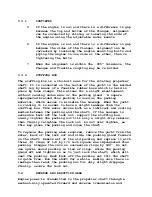
3.3 CONTINUED
Example: If the distance from the face of the mast to the bow
(“J" on the sail plan) is 10 feet and a line 15 feet
distant (LP) was drawn parallel to the headstay then
any Genoa with a clew (aft lower corner of sail) on
that line would be a "150% Genoa".
It is extremely important to realize that these large sails can
concentrate very high loads over a very small area, hence the
gear must have high safe working loads.
All of the Genoa Gear has been designed and prepared to accept
those extreme loads. The track is thru bolted and all blocks
have ample safety factors. All other fittings are of the best
possible design and strength for the job intended.
Most fitting failures occur from improper usage, usually by
trying to use an under designed fitting instead of the proper
factory recommendation. If loads are expected to come close to
the safe working load of the block, then the next size 1arger
must be used. Please remember that if a line turns back on
itself, like all halyards, spinnaker sheets and guys, then the
load on that block is almost doubled.
Genoa Gear consists of a braided tail stainless steel halyard
with halyard winch, sheets, inboard adjustable fairlead blocks,
two speed primary winches and related cleats. Snatch blocks can
be added as outboard fairleads by attachment to the perforated
toe rail. Due to the large loads imposed on Genoa sheets, it is
important that the angle from a sheet fairlead block does not
impart a twisting movement on the block that could lead to
failure. The primary winches are located towards the after end
of the cockpit coamings to provide a fair lead for a large range
of genoas without the need for a footblock. If an oversized
Genoa is used that twists the fairlead block, then a footblock
should be added for turning the sheet.
When the Genoa is hanked on, one will notice two tack hooks on
the stemhead. The tack cringle of the headsail should be placed
directly on this hook doing away with the need of a shackle. The
halyard leads to a winch and cleat on the port side of the mast
that provides sufficient power to tension the luff. Increasing
tension on the halyard will tend to pull the draft forward in
the sail. Angle of twist as well as relative foot and leech
tension can be adjusted by fairlead position and sheet tension.
Summary of Contents for 299
Page 1: ......
Page 2: ......
Page 53: ......
Page 54: ......
Page 55: ......
Page 56: ......
Page 57: ......
Page 58: ......
Page 59: ......
Page 60: ......
Page 61: ......
Page 62: ......
Page 63: ......
Page 64: ......
Page 65: ......
Page 66: ......
Page 67: ......
Page 68: ......
Page 69: ......
Page 70: ......
Page 71: ......
Page 72: ......














































